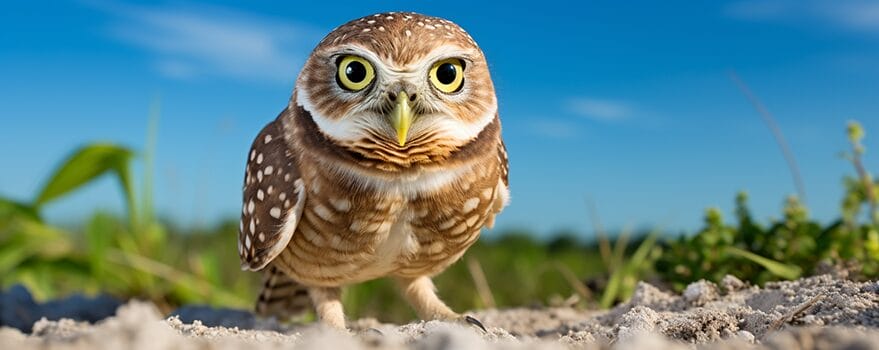
All About Florida Owls
Florida’s diverse landscapes—wetlands, pine forests, coastal regions—make it an ideal habitat for a variety of unique wildlife, especially owls. These nocturnal birds captivate nature lovers with their mysterious calls, silent flight, and crucial role in the ecosystem.
As natural hunters, Florida owls help balance the ecosystem by controlling rodent populations, and their presence enriches the state’s biodiversity.
In this guide, we’ll dive into Florida’s owl species, explore their habitats and behaviors and where you can spot them, and examine the challenges they face. You’ll also find intriguing insights into their cultural significance, unique adaptations, and tips for spotting these fascinating birds in the wild.

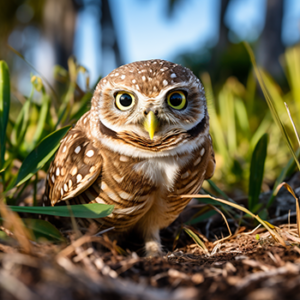
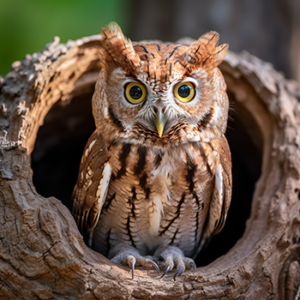
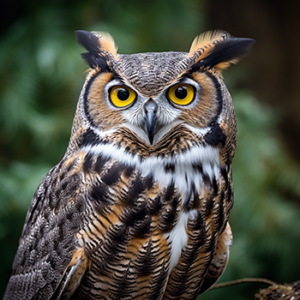
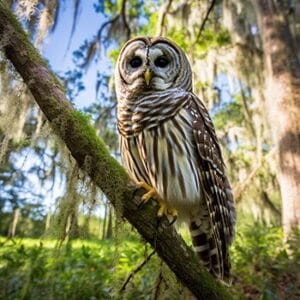
Species of Florida Owls
Florida’s diverse ecosystems support several owl species, each adapted to its unique habitat. Here’s a quick guide to the state’s most commonly observed owls:
Eastern Screech Owl
- Size: Small, around 6–10 inches in length with a 19-24 inch wingspan.
- Habitat: Found in suburban areas, parks, forests and woodlands near water.
- Behavior: Mostly nocturnal, but sometimes active during the day.
- Call: Known for its distinctive trilling call that often echoes through the night.
- Notable Features: One of the smaller owls, making it easier to spot in populated areas.
Barred Owl
- Size: Approximately 19-24 inches long with a 40-50 inch windgspan.
- Habitat: Prefers dense forests and wooded swamps.
- Behavior: Primarily nocturnal, known for their distinctive hooting calls.
- Call: Recognizable “Who cooks for you?” call.
- Diet: Hunts small mammals and birds in shaded, wetland areas.
Great Horned Owl
- Size: Large, about 18-24 inches long with a wingspan that can reach up to 5 feet.
- Habitat: Adapts to various environments, from urban areas to remote woodlands, forests and swamps.
- Call: Deep hoots that resonate powerfully, marking its territory.
- Notable Features: Famous for its “horned” tufts, making it a striking and dominant predator, powerful tlons and distinctive hooting calls.
Burrowing Owl
- Size: Small, about 7-10 inches long with a 20-24 inch wingspan.
- Habitat: Unique for nesting in underground burrows rather than trees, often in open grasslands, prairies and other open areas like golf courses and airports.
- Behavior: Active during daylight, commonly seen perched near its burrow.
- Notable Features: Often spotted during the day, making it one of the more visible owls and can often be spotted at golf courses, airports and pastures.
Barn Owl
- Size: Medium-sized, with a wingspan of around 3.5 feet.
- Habitat: Prefers open areas like grasslands, marshes, agricultural fields, and even suburban spaces. Often nests in barns, abandoned buildings, and other man-made structures.
- Call: Known for its eerie, raspy screech, which sounds quite different from the hoots of other owl species.
- Diet: Primarily hunts small mammals, especially rodents, making it a key player in natural pest control.
- Notable Features: Easily recognized by its distinctive heart-shaped face and pale, ghostly appearance. Its silent flight and haunting call make it a memorable sight (and sound!) in the Florida night.
Short-eared Owls
- Size: Medium-sized, with a wingspan of about 3.3–3.7 feet.
- Habitat: Prefers open landscapes such as grasslands, marshes, prairies, and agricultural fields. They can sometimes be seen hunting over marshy areas in Florida.
- Behavior: Unlike many other owls, short-eared owls are crepuscular and often active during the day, especially around dawn and dusk, making them easier to spot.
- Diet: Primarily small mammals, but they may also eat birds and insects.
- Notable Features: Named for the short tufts on their heads (often hard to see), they have a distinctive “moth-like” flight pattern, with smooth, low, and erratic movements over open fields.
While short-eared owls are not year-round residents, their seasonal presence adds to Florida’s diverse array of bird species, especially for birdwatchers hoping to spot this unique, day-hunting owl during the winter months.
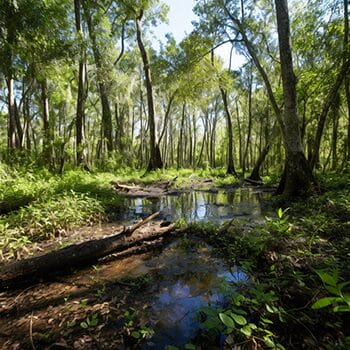

Threats to Florida Owls
Despite their adaptability and resilience, Florida owls face numerous threats that jeopardize their populations.
Habitat loss is one of the most significant challenges they encounter. As urban development expands across the state, natural habitats are increasingly fragmented or destroyed.
This encroachment not only reduces available nesting sites but also diminishes the abundance of prey species that owls rely on for survival.
The Burrowing Owl is particularly vulnerable due to its dependence on specific habitats such as grasslands and agricultural areas that are often converted for development or intensive farming practices.
In addition to habitat loss, Florida owls are also threatened by environmental pollution and climate change.
Pesticides used in agriculture can accumulate in the food chain, leading to health issues for owls that consume contaminated prey.
These threats underscore the urgent need for conservation efforts aimed at protecting both the owls themselves and their habitats to ensure their survival in an ever-changing environment.
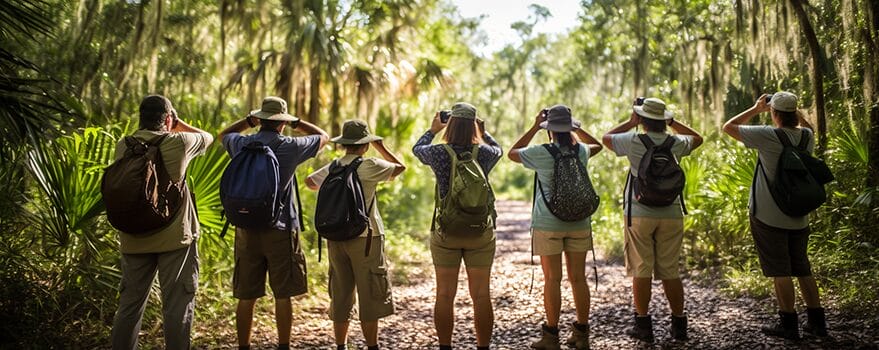
Conservation Efforts for Florida Owls
Recognizing the importance of protecting Florida’s owl populations has led to various conservation initiatives aimed at safeguarding these remarkable birds. State and federal laws provide protections for many owl species, making it illegal to harm or disturb them without proper permits. Organizations dedicated to wildlife conservation work tirelessly to raise awareness about the threats facing owls and promote habitat preservation efforts.
For instance, habitat restoration projects focus on re-establishing native vegetation in areas where owls have been displaced due to development or environmental degradation.
In addition to habitat restoration, public education campaigns play a crucial role in conservation efforts. By informing residents about the significance of owls in local ecosystems and encouraging responsible practices—such as reducing pesticide use—conservationists aim to foster a sense of stewardship among communities.
Citizen science initiatives also engage local residents in monitoring owl populations and reporting sightings, which helps researchers gather valuable data on distribution patterns and population trends.
These collaborative efforts highlight the importance of community involvement in conservation strategies and demonstrate that protecting Florida’s owls requires a collective commitment from all stakeholders.
Florida Owls in Popular Culture
Owls have long held a prominent place in popular culture, often symbolizing wisdom, mystery, and even magic. In literature and folklore around the world, these enigmatic birds have been depicted as wise guides or guardians of knowledge.
Their haunting calls and striking appearances have inspired countless stories that explore themes of nature’s mysteries and the interconnectedness of life. Moreover, owls have become iconic figures in various media forms—from children’s books featuring whimsical owl characters to films that portray them as mystical beings with special powers.
Interesting Facts about Florida Owls
Florida owls are not only captivating creatures but also possess a wealth of intriguing characteristics that set them apart from other birds.
For instance, did you know that owls have fixed eye sockets? This unique anatomical feature means they cannot move their eyes like humans do; instead, they can rotate their heads up to 270 degrees!
This remarkable ability allows them to survey their surroundings without moving their bodies—an essential adaptation for spotting potential prey or predators while remaining concealed.
Another fascinating aspect of owls is their method of hunting; they are known for their silent flight due to specialized feather structures that minimize noise during flight. This stealthy approach enables them to sneak up on unsuspecting prey with remarkable efficiency.
Additionally, owls regurgitate pellets containing undigested bones, fur, and feathers after feeding—a behavior that provides valuable insights into their diet for researchers studying these birds’ ecological roles.
These unique traits contribute to the allure of Florida owls and highlight their importance within the state’s diverse ecosystems.
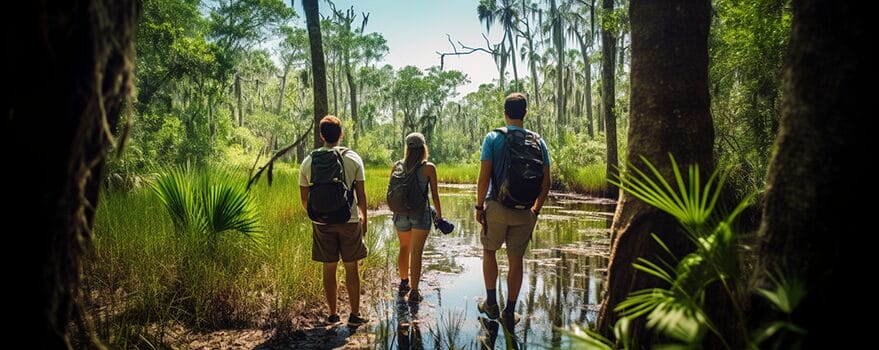
How to Spot Florida Owls in the Wild
Do you want to see Florida owls in their natural habitats? Here are several tips and techniques that can enhance your chances of spotting these elusive birds.
First and foremost, timing is crucial; since owls are primarily nocturnal creatures, dusk and dawn are optimal times for viewing them as they become active during these hours.
Visiting areas known for owl populations—such as parks with dense tree cover or open grasslands where Burrowing Owls reside—can increase your likelihood of encountering these fascinating birds.
When searching for owls, it’s essential to remain quiet and patient; sudden movements or loud noises can easily scare them away. Look for signs of owl activity such as pellets beneath trees or distinctive calls echoing through the night air.
Binoculars can be invaluable tools for observing owls from a distance without disturbing them; focusing on tree branches or open fields where they might perch can yield rewarding sightings.
Engaging with local birdwatching groups or participating in guided owl walks can also provide valuable insights into owl behavior while enhancing your overall experience in nature.
FAQs About Florida Owls
What types of owls can be found in Florida?
In Florida, you can find a variety of owl species including the Eastern Screech Owl, Barred Owl, Great Horned Owl, Burrowing Owl, Barn Owl, and the rare Florida Burrowing Owl.
Where do owls in Florida typically live?
Owls in Florida can be found in a variety of habitats including forests, swamps, marshes, and urban areas. Some species, like the Burrowing Owl, are known to inhabit open grasslands and prairies.
What do owls in Florida eat?
Owls in Florida are carnivorous and primarily feed on small mammals such as mice, rats, squirrels, and rabbits. They may also consume birds, insects, and reptiles.
Are owls in Florida endangered?
Some owl species in Florida, such as the Florida Burrowing Owl, are considered threatened or endangered due to habitat loss and human disturbance. Conservation efforts are in place to protect these species.
When is the best time to spot owls in Florida?
Owls are nocturnal creatures, so the best time to spot them in Florida is during the evening and early morning hours. Some species may also be active at dusk and dawn.
As an Amazon Associate I earn from qualifying purchases at no additional cost to you.


